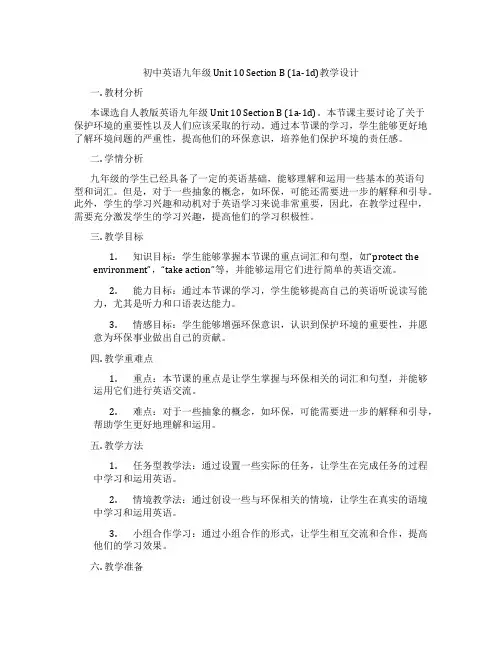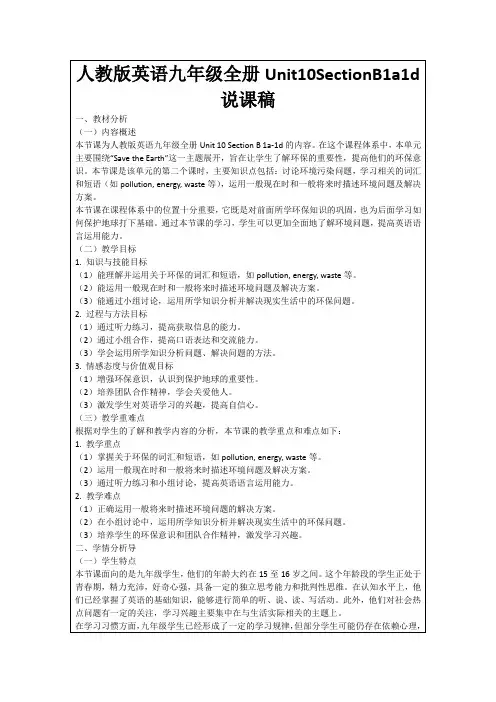人教新目标英语九年级Unit10 Section B (1a1d) 导学案(无答案)
- 格式:docx
- 大小:26.52 KB
- 文档页数:2




人教版英语九年级全一册教案:Unit10 SectionB(1a-1d )(word 版)【教材版本与册数】新目标人教版九年级下册Unit10 SectionB(1a-1d)教案【单元名称】Unit 10 Y ou’re supposed to shake hands.【课时】Section B (1a-1d) (第4课时)【课型】Listening and speaking (听说课)【本课时话题】餐桌礼仪【本课时重点掌握目标】1、能够通过听,学习与餐桌礼仪有关的词汇及表达;2、能够运用S ection A 的目标语言(be supposed to)谈论习俗和应该怎么做。
【本课时教材内容分析】教材分析本课时在S ection A 的基础上对礼仪习俗有所拓展,主要介绍不同国家的餐桌礼仪。
1a-1d 部分包含两个任务,任务一:学习和理解更多有关习俗的短语;任务二:丰富和延伸S ection A 的语言表达。
活动1a 让学生阅读不同国家的餐桌礼仪描述,根据已有的知识进行判断,为下面的听说活动做铺垫。
活动1b-1c 通过文本的听力训练完成相应的任务,1d 部分进一步巩固有关餐桌礼仪的句型和对话。
【通过本课时的学习学生需掌握哪些综合技能】通过本课时的学习,学生通过听力,能够理解更多关于习俗的短语,丰富习俗的语言表达。
语言创编能够提高学生第 2 页第 3 页语言表达能力,进一步巩固有关礼仪习俗的表达。
1、语言知识目标通过教师自身的情景式导入和与学生互动的问答形式,学习和巩固该话题下的词汇句型,激发调动学生的求知欲,熟 练使用以下词汇、短语和句型。
熟练掌握短语: 1) table manners your chopsticks句型: 1) Y ou ’re not supposed to stick your chopsticks into your food.2) It ’s impolite to point at anyone with your chopsticks.3) Y ou shouldn ’t start eating first if there are older people at the table.2、语言技能目标1) 听取关键信息2) 运用目标语言描述不同国家的餐桌礼仪及建议。


初中英语九年级 Unit 10 Section B (1a-1d)教学设计一. 教材分析本课选自人教版英语九年级Unit 10 Section B (1a-1d)。
本节课主要讨论了关于保护环境的重要性以及人们应该采取的行动。
通过本节课的学习,学生能够更好地了解环境问题的严重性,提高他们的环保意识,培养他们保护环境的责任感。
二. 学情分析九年级的学生已经具备了一定的英语基础,能够理解和运用一些基本的英语句型和词汇。
但是,对于一些抽象的概念,如环保,可能还需要进一步的解释和引导。
此外,学生的学习兴趣和动机对于英语学习来说非常重要,因此,在教学过程中,需要充分激发学生的学习兴趣,提高他们的学习积极性。
三. 教学目标1.知识目标:学生能够掌握本节课的重点词汇和句型,如“protect theenvironment”,“take action”等,并能够运用它们进行简单的英语交流。
2.能力目标:通过本节课的学习,学生能够提高自己的英语听说读写能力,尤其是听力和口语表达能力。
3.情感目标:学生能够增强环保意识,认识到保护环境的重要性,并愿意为环保事业做出自己的贡献。
四. 教学重难点1.重点:本节课的重点是让学生掌握与环保相关的词汇和句型,并能够运用它们进行英语交流。
2.难点:对于一些抽象的概念,如环保,可能需要进一步的解释和引导,帮助学生更好地理解和运用。
五. 教学方法1.任务型教学法:通过设置一些实际的任务,让学生在完成任务的过程中学习和运用英语。
2.情境教学法:通过创设一些与环保相关的情境,让学生在真实的语境中学习和运用英语。
3.小组合作学习:通过小组合作的形式,让学生相互交流和合作,提高他们的学习效果。
六. 教学准备1.教学材料:教材、多媒体课件、录音机、磁带等。
2.教学环境:教室、黑板、投影仪等。
七. 教学过程1.导入(5分钟)通过一些与环境相关的问题,如“你们认为环保重要吗?为什么?”等,引导学生思考环保的重要性,激发他们的学习兴趣。


You’re supposed to shake hands教学目标知识与技能:1.能掌握以下重难点句子:You’re supposed to …You’re not supposed to…It’s impolite to …You shouldn’t …2.提高学生的听力水平,培养学生的阅读能力,理解关键词和短语的能力。
过程与方法:直观看图,反复听力,阅读获取信息。
情感态度价值观:通过对一些国家的风俗习惯和饮食文化。
餐桌礼仪的了解,进一步提高学生对文明生活的认识。
教学方法直观展示法,情境创设法学习方法模仿,讨论与交流。
教学准备图片,录音机,多媒体。
教学过程设计意图Step 1 GreetingsGreet the students as usual.Step 2 Warming up让学生展示“哥伦比亚和瑞士的礼仪”的短文。
对于好的给予鼓励。
Step 3 Lead in利用大屏幕展示一些国家吃饭的情景,或一些在餐馆吃饭的图片,边放边介绍,让学生对中西方就餐文化有所了解,并引入新课。
Step 4 Presentation1. Work on 1a. How much do you know about table manners around the world? Take the following quiz. Circle T for true or F for false after each sentence. Make students be interested in and get involved in the topic of this class.Mind your manners! 1. In India, you ’re supposed to eat with your hands. T F 2. In China, you ’re not supposed to stick your chopsticks into the food. T F3. In Korea, the youngest person is expected to start eating first. T F4. In France, you ’re supposed to put your bread on the table. T F5. In China, it ’s impolite to use your chopsticks to hit an empty bowl. T F1)先让学生自己做,老师指导,让他们理解每个句子的意思。



新目标九年级Unit10全单元导学案(6课时)(英语教案)Unit 10 You’re supposed to shake hands.课时分解第一课时 Section A (1a ~ 2d )II. 课堂环节§自主学习方案【自学自查】根据句意及首字母提示完成单词。
1. He always made some mistakes when he was a little boy.2. People in Korea often bow when they meet for the first time.3. In China, people often shake hands when they meet in the street.4. What are you supposed to do when you meet someone?5. It ’s our custom to greet people by giving th em flowers. §课堂导学方案 Step 1 情景导入Teacher: When you are new to a place, you need to know about some special customs the place has. You need to ask some one about them. What should you say first? Questions: Teacher: In you country, ___________when you meet someonefor the first time?Students: You are supposed to shake hands / kiss / bow.① what are you supposed to do? ② what should you do? ……环节说明:通过课前的一个师生问答互动引入新课的话题Step 2 完成教材1a-1c 的任务【操作案例】1. 要求学生看课本P75 1a 部分的图片。
Unit 10 You’re supposed to shake hands.课时分解第一课时 Section A (1a ~ 2d )II. 课堂环节 §自主学习方案 【自学自查】根据句意及首字母提示完成单词。
1. He always made some mistakes when he was a little boy.2. People in Korea often bow when they meet for the first time.3. In China, people often shake hands when they meet in the street.4. What are you supposed to do when you meet someone?5. It ’s our custom to greet people by giving them flowers. §课堂导学方案 Step 1 情景导入Teacher: When you are new to a place, you need to know about some special customs the place has. You need to ask some one about them. What should you say first? Questions:Teacher: In you country, ___________when you meet someone for the first time?Students: You are supposed to shake hands / kiss / bow.① what are you supposed to do? ② what should you do? ……环节说明:通过课前的一个师生问答互动引入新课的话题Step 2 完成教材1a-1c 的任务 【操作案例】1. 要求学生看课本P75 1a 部分的图片。
Unit10 SectionB〔1a-1d〕精品导学案【学习目标】重点单词与短语:empty, mind your manners ,eat with hands, stick the chopsticks into the food, hit an empty bowl, point at anyone wth the chopsticks重点句子:1. In India, you are supposed to eat with your hands. 在印度,你应当用手吃饭。
2. In Korea, the youngest person is expected to start eating first.在韩国,年纪最小的应领先开场吃饭。
3. In China, it’s impolite to use your chopsticks to hit an empty bowl.在中国,用你的筷子敲打空碗是不礼貌的。
4. You shouldn’t stick your chopsticks into your food.二、能够运用目标语言谈论不同国家的餐桌礼仪。
三、学会比拟不同文化的差异,风俗和礼仪,增强学生的人际交往能力。
教学难点:能够运用目标语言谈论不同国家的餐桌礼仪。
【学习过程】自学自查:根据句意及首字母提示完成单词。
’s i___________ to speak loudly in public.2. The bag is e___________ and I can’t find anything in it.3. It’s not polite to s_____________ your chopsticks into your food.4. The oldest person is supposed to start e____________ first in China.5. Don’t p___________ at anyone with your chopsticks while eating.6.注意你的礼仪_________________________8.把筷子插在食物上_______________________________________Before listening1. Lead-in:通过图片导入本课所学内容。
Unit10 SectionB(1a-1d)教案一、Teaching Aims:1. Language Goals:1) Words: greet, relaxed, value, drop by, capital, after all, noon, get mad, make an effort2) Sentences:A: What are you supposed to do when you meet someone for the first time?B: You are supposed to shake hands.S1: What are the other Chinese table manners?S2: We are supposed to eat after the old people.S3: We are not supposed to put elbows on the table.S4: We are not supposed to talk aloud at the dinner table.2. Ability Goals:Use “be supposed to do” to make sentences.3. Moral Goals:Help students know the different customs in different countries. We should know when in Rome, do as the Romans do.二、Teaching important & difficult points1. Teaching important points: Words and sentences2. Teaching difficult points:Use “be supposed to do” to make sentences to express the different customs in different countries.三、Teaching Aids PPT, pictures四、Teaching MethodsCommunicative teaching method; Listening, speaking, reading, writing methods.五、Teaching ProceduresⅠ. Lead-in1. Watch a short movieT: Hello, everyone! We know different countries have different customs. But how do we display impeccable manners? Let’s see a movie about how to behave good m anners. How do you feel after watching the movie?2. After watching movie, Ss try to answer the questions.Ⅱ. Presentation1. See teaching objectsTo learn the table manners around the world.To read, listen and speak how you are supposed to behave at dinner tables in China.2. Students look at pictures and say different customs in different countries by using “be supposed to do” to make sentences.3. Ask students to turn to P77 to finish 1a and check the answers.4. Ask students about Chinese table manners:After seeing the pictures and say Chinese table manners.Summarize Chinese table manners.Ⅲ. Listening1. T: Steve is going to China to study. His friend Yang Ming is telling him about table manners in China. Now listen and number the pictures in the order you hear them.2. Play the recording twice. Students number the pictures and match sentences parts.3. Play the recording again. Check the answers with the Ss.Ⅳ. Group workAsk student to make conversations.E.g.S1: What are the other Chinese table manners?S2: We are supposed to eat after the old people.S3: We are not supposed to put elbows on the table.S4: We are not supposed to talk aloud at the dinner table.Give students two minutes to make their conversations and perform their conversations.Ⅴ. Writing1. Ask students to summarize the phrases about Chinese table manners.2. Let some Ss read the information about writing and ask them to use sentence.3. Ss try to write a composition about Chinese table manners by using information in the chart. (Give students five minutes to write their compositions)4. Invite some students to read their compositions and check if there are mistakes.Ⅵ. SummaryAsk students to summarize the key phrases.Ⅶ. Homework:1. Find the differences about the table manners between France and China.2. Write a composition about Chinese table manners.。
Unit 10 You’re supposed to shake hands.
Section B (1a-1d) 导学案(第三课时)
【学习目标】
1.单词和短语:empty,chopsticks,behave,stick ,point,unusual ,point at,table
manners,for one thing,be excited about,use sth. to do sth. ,stick…into…
2.句型:—You’re (not )supposed to ...
—We’re (not) supposed to …;
—It’s impolite to ...
—You shouldn’t ...
—It’s rude to stick your chopsticks into your food.
【学习过程】
一、课前预习
1.预习1a-1d内容,写出下列单词和短语,然后小组内互查。
(1)餐桌礼仪_________________ (2)用手吃东西_______________
(3)最年轻的人_______________ (4)开始吃东西_______________
(5)一名交换学生____________ (6)将…插入________________
(7)对……感到兴奋(8)首先
(9)指着(10)有点紧张
2.翻译下列句子或短语。
(1)It’s rude to point at anyone with your chopsticks. _________________________
(2)I don’t know how to behave at the dinner table._________________________
(3)It’s impolite to stick your ch opsticks into your food.. _________________
(4)You must be excited about leaving for China tomorrow,Steve!
_______________________
(5)It’s impolite to use your chopsticks to hit an empty bowl.
二、课上活动
(一)导入。
判断下列餐桌行为在中国是礼貌还是粗鲁,礼貌用P粗鲁用R。
(1) pick up your bowl to eat ( ) (2) eat with your hands ( )
(3) talk at the table ( ) (4) start eating first. ( )
(5) use your chopsticks to hit an empty bowl ( )
(二)判断正误处理1a .
Mind your manners!
1. In India,you’re supposed to eat with your hands. T F
2. In China,you’re not supposed to stick your chopsticks into the food. T F
3. In Korea,the youngest person is expected to start eating first. T F
4. In France,you’re supposed to put your bread on the table. T F
5. In China,it’s impolite to use your chopsticks to hit an empty bowl. T F
(三)听力训练(1b &1c)
1.听录音,完成1b排序。
2.熟读1c中的句子。
3.然后再听录音,完成1c的听力任务。
(1)You’re not supposed to ... a. stick your chopsticks into your food.
(2)It’s impolite to ... b. point at anyone with your chopsticks.
(3)You shouldn’t ... c. start eating first if there are older people at the table.
4.听力拓展,再听一遍,完成《自主学习与指导课程》P120习题II的短文填空。
5.对照听力原文再听一遍,核对答案。
注意单词的发音和语音语调。
(四)说的训练。
(1d)
小组内讨论在中国其他的餐桌礼仪,并以对话的形式给大家表演。
Model: A: In China,We’re supposed to our bowl to eat.
B: Yes,and it’s to eat or drink while walking down the street.
三、语言知识
1. first one thing 首先同义词组有
2. stick…into… 把……刺/插进……
Don’t your chopsticks your food..不要把你的筷子插入食物。
3. empty 做形容词时意为“空的”,也可作为动词,意为“倒空,排空。
”
一个空瓶子They emptied the biscuits onto the plate.
他们把饼干倒在盘子里。
4. be excited about 对……感到兴奋一个令人兴奋的故事
be excited about +doing sth. 对做某事感到激动、兴奋
5. exchange即可作名词也可作动词,意为“交换”。
一名交留生
They exchanged ideas as soon as they saw each other.
他们一见面就交换了彼此的看法。
6. table manners 餐桌礼仪manner 做名词,意为“方式,方法;(pl.)礼貌;礼仪”。
7. rude 形容词粗鲁的;无理的。
常用词组be rude to sb.,意思是“对某人无理”。
四、课堂达标检测题
选词并用其正确形式填空。
(point,rude,make noise,stick,eat)
1. You’d better not talk loudly or laugh while ______ at the table.
2.The geography teacher is to the map on the wall.
3. It’s ______ to speak with your mouth full.
4. Don’t ______ your chopsticks into the food.
5. Be quiet! You shouldn’t ______ in the library.。